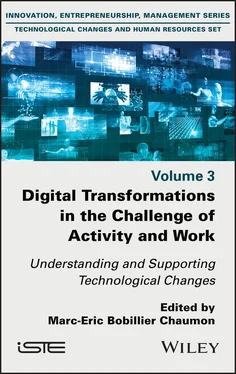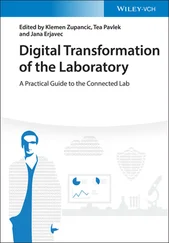Digital Transformations in the Challenge of Activity and Work
Здесь есть возможность читать онлайн «Digital Transformations in the Challenge of Activity and Work» — ознакомительный отрывок электронной книги совершенно бесплатно, а после прочтения отрывка купить полную версию. В некоторых случаях можно слушать аудио, скачать через торрент в формате fb2 и присутствует краткое содержание. Жанр: unrecognised, на английском языке. Описание произведения, (предисловие) а так же отзывы посетителей доступны на портале библиотеки ЛибКат.
- Название:Digital Transformations in the Challenge of Activity and Work
- Автор:
- Жанр:
- Год:неизвестен
- ISBN:нет данных
- Рейтинг книги:4 / 5. Голосов: 1
-
Избранное:Добавить в избранное
- Отзывы:
-
Ваша оценка:
- 80
- 1
- 2
- 3
- 4
- 5
Digital Transformations in the Challenge of Activity and Work: краткое содержание, описание и аннотация
Предлагаем к чтению аннотацию, описание, краткое содержание или предисловие (зависит от того, что написал сам автор книги «Digital Transformations in the Challenge of Activity and Work»). Если вы не нашли необходимую информацию о книге — напишите в комментариях, мы постараемся отыскать её.
Digital Transformations in the Challenge of Activity and Work — читать онлайн ознакомительный отрывок
Ниже представлен текст книги, разбитый по страницам. Система сохранения места последней прочитанной страницы, позволяет с удобством читать онлайн бесплатно книгу «Digital Transformations in the Challenge of Activity and Work», без необходимости каждый раз заново искать на чём Вы остановились. Поставьте закладку, и сможете в любой момент перейти на страницу, на которой закончили чтение.
Интервал:
Закладка:
2) The following thematic part focuses on the new ways of working caused or accelerated by digital transformations, providing analysis and feedback from various research studies.
Thus, Chapter 7by Emilie Vayrereports on the psychosocial and socio-professional issues of telework deployment within work organizations, based on a summary of various research works and publications. The author also suggests steps that can be taken to mark out the process of deploying telework in work structures. Chapter 8by Elodie Chambonnièreand Jacqueline Vacherand-Revelis based on an ethnographic study in the building sector that deals with the reconfiguration of pre-existing management practices of various key players on the building site and occupational risk prevention activity, following the introduction of a business application. The authors demonstrate the advantage of an ethnographic approach that immerses itself in the heart of this activity in order to be able to understand the multiple determinants of the evolution of these newly digitized managerial practices. Chapter 9by Anne-Cécile Lafeuillade, Flore Barcellini, Willy Buchmannand Tahar-Hakim Benchekrounfocuses on collaborative robotics (cobotics) and the way it is considered and determined by the organizational projects of managers of SMEs. The authors demonstrate the importance of starting from the reality of the activity to shape the “desires” of transformation, a reflection similar to that of Irène Poidi, Marc-Eric Bobillier Chaumonand Jacqueline Vacherand-Revelin Chapter 10. These authors show how technological artifacts are mobilized at different stages and for different functions in the process of creating innovative companies by young entrepreneurs. These technical devices then take on a status and a particular trajectory of use depending on the situations and activities in which they are employed. Finally, Chapter 11by Maria Ianeva, Raluca Ciobanuand Chiara Laion the new physical territories of digital activity proposes to question the outlines and challenges of space as an object of research and action in digital transformations. Their contribution seeks to qualify the psychosocial and organizational implications of these complex socio-technical devices (flexible spaces, unassigned positions), based on research carried out within the IT subsidiary of a large French group.
3) The third thematic part discusses more specifically the psychosocial, socio-organizational and occupational impacts of technology diffusion in work activity .
Chapter 12by Maxime Besenvaland Alexandra Bidetlooks at the beginnings of engagement in digital, creative and collective work. Based on an ethnographic study of the sociology of work and uses in the video game design sector, the authors ask how far we can invest in and develop the opportunities offered by digital transformations – in terms of permanent and collective reconfiguration of the product of work – without threatening the possibility of workers engaging in it. Chapter 13by Florence Cros, Marc-Eric Bobillier Chaumonand Bruno Cuvillierraises the issue of the obsolescence of the skills of older workers in the face of the challenges of technological change. This chapter illustrates that older people have major experiential and collective resources that enable them to cope with these transformations, and, above all, to regulate technical failures or work situations not covered by the new systems. Chapter 14, the last chapter of Part 3, by Pauline Crouzatand Marc-Eric Bobillier Chaumonsets out, on the one hand, to specify how the collective activity of an aeronautical engineering department can be reconfigured under the impetus of technology and, on the other hand, to examine the manifestations, resources and limits of these collective practices mediated by technology.
4) The fourth and final thematic part covers the methods and approaches that can be used to understand, design and support digital transformation projects .
Thus, Chapter 15by Jean-Marc Robert, Antoine Martin, Mitra Taraghi, Clément Colin, Masood Maldar, Flavie Bonneviotand Eric Brangieraims to explain the place and role of the prospective ergonomics (PE) approach in the development of future products, services, processes and systems. The authors present two illustrations of innovative projects that apply the approach and methods of this perspective. Chapter 16by Laurent Van Belleghemdescribes the interest of the activity simulation method in order to fully explain the new work configurations that these transformations foreshadow and to help design them. Two intervention experiments illustrate these ways of anticipating and co-designing probable future work. Chapter 17by Clotilde Coronand Patrick Gilbertdeals with the specificities of change management in the context of digital transformations, because they can be an amplifier, or even a catalyst, of social and professional inequalities. The authors present a model of change management that takes into account the specificities of technological change. Chapter 18, the last chapter by Marc-Eric Bobillier Chaumon, returns to the concepts and models of technological acceptability, which are crucial in the process of adopting and deploying new technologies. The chapter also discusses their contributions and limitations. Based on the situated acceptance approach, he outlines the methods that, in his view, allow us to explore the acceptance of emerging technologies, based on the analysis of acceptable developments related to digitized activities.
Introduction written by Marc-Eric BOBILLIER CHAUMON.
1
Emerging Technologies and Issues for Activity and Occupational Health
The question of the introduction of emerging technologies and their constant renewal in organizations fundamentally refers to the place and role that these devices play in business, as well as how they can affect activity and health at work. Considered as a prospective reflection attempting to grasp the logic and modalities of the digital transformations underway, the ambition of this chapter is: (1) first, to identify and characterize the emerging technologies that are being deployed in the company; (2) to discuss their impact on the activity and well-being of employees, demonstrating the uses and paradoxical effects that these devices may have on work; and (3) finally, to reflect on the psychosocial function of these devices as potential operators of health and development of the profession.
1.1. Introduction
For several years now, we have been witnessing a major reconfiguration of the conditions in which work is carried out, in their nature (intensification, dematerialization, acceleration), in their modalities (remote working, nomadism, fragmentation, virtual teams) and in their reference points (fragmentation and dispersion of activity, multi-activity), due to the deployment of innovative technical solutions which are multiplying. The impact on the human factor is not neutral. The implementation of these emerging devices can, at best, provoke simple transfers of use and learning; they are iterative or incremental technologies. At worst, they can lead to real disruptions in use; they are then disruptive technologies (Bobillier Chaumon 2017). The latter require a profound rethinking of the user experience, requiring new ways of doing, thinking, organizing and collaborating at work. New organizational and socio-cognitive models are then required to work with these devices (de Terssac and Bazet 2007; Ajzen et al. 2015), with strong implications for the health and well-being of employees (Bobillier et al. 2015). Anastassova (2006) and Loup-Escande and Burkhardt (2019) identify four specific characteristics of emerging technologies: (1) an innovative character, an important technological advance, partially achieved or in the making; (2) unclear and undifferentiated uses; (3) several limitations that slow down its massive application; and (4) a promise of transformation of the economic and social context in which it will be introduced.
Читать дальшеИнтервал:
Закладка:
Похожие книги на «Digital Transformations in the Challenge of Activity and Work»
Представляем Вашему вниманию похожие книги на «Digital Transformations in the Challenge of Activity and Work» списком для выбора. Мы отобрали схожую по названию и смыслу литературу в надежде предоставить читателям больше вариантов отыскать новые, интересные, ещё непрочитанные произведения.
Обсуждение, отзывы о книге «Digital Transformations in the Challenge of Activity and Work» и просто собственные мнения читателей. Оставьте ваши комментарии, напишите, что Вы думаете о произведении, его смысле или главных героях. Укажите что конкретно понравилось, а что нет, и почему Вы так считаете.












